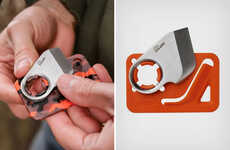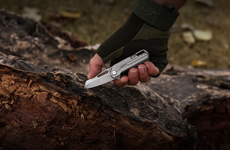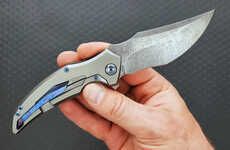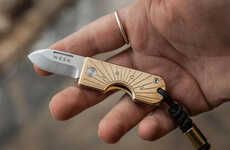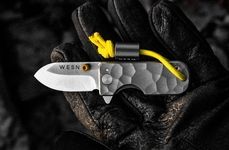
This Pocket Knife is Made from the Japanese 'Higonokami' Design
David Ingram — October 27, 2015 — Art & Design
References: shop.coolmaterial
This 'Raw Steel Higonokami Pocket Knife' is a portable version of a traditional style of Japanese blades.
The original version of the 'Higonokami' knife traces its roots all the way to the late 18th century, where it became a popular style of knife in Japan. The blade was notable because it was specially crafted not to lock into place. Eventually, this style of blade became banned in 1961, and dipped in popularity because craftsman could no longer legally smith the blades.
This pocket version of the traditional blade upholds the tradition with it's unique blade design colored in a traditional raw steel motif. This hand-forged, seven inch knife also features a special lever to draw the blade, a slim profile to easily fit in your pocket and is accented with a maker's mark in Japanese characters.
The original version of the 'Higonokami' knife traces its roots all the way to the late 18th century, where it became a popular style of knife in Japan. The blade was notable because it was specially crafted not to lock into place. Eventually, this style of blade became banned in 1961, and dipped in popularity because craftsman could no longer legally smith the blades.
This pocket version of the traditional blade upholds the tradition with it's unique blade design colored in a traditional raw steel motif. This hand-forged, seven inch knife also features a special lever to draw the blade, a slim profile to easily fit in your pocket and is accented with a maker's mark in Japanese characters.
Trend Themes
1. Pocket-sized Traditional Blades - The trend of pocket-sized traditional blades could spark innovation in the market for mobile personal tools.
2. Raw Steel Design - The trend of raw steel designs can lead to innovation opportunities in the fashion accessories industry by integrating this aesthetic into their products.
3. Revival of Traditional Blades - Reviving traditional blade designs can disrupt the art and design industry by promoting heritage craftsmanship.
Industry Implications
1. Tools and Hardware - The tools and hardware industry can explore innovation in the development of pocket-sized tools by adopting traditional blade designs.
2. Fashion Accessories - The fashion accessories industry can adopt the raw steel aesthetic popularized by traditional blades to create unique and stylish products.
3. Art and Design - The art and design industry can promote heritage craftsmanship by featuring and promoting traditional blade designs in their exhibitions and events.
4.6
Score
Popularity
Activity
Freshness


